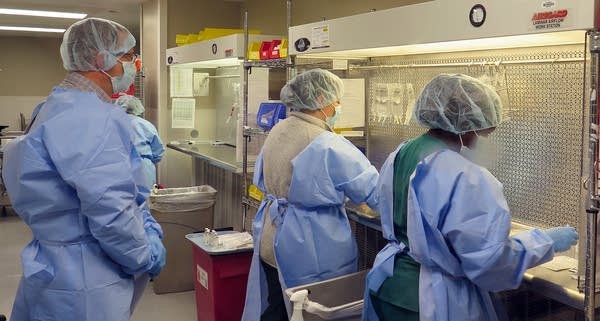Facing shortage of IV bags, what's a hospital to do?

Go Deeper.
Create an account or log in to save stories.
Like this?
Thanks for liking this story! We have added it to a list of your favorite stories.
The fallout from Hurricane Maria has made its way into Minnesota hospitals.
When the storm hit Puerto Rico last summer, it devastated facilities that produce IV bags — which are critical for treating dehydration and delivering medicines.
It has been a challenge for months and hospitals in Minnesota and across the country are still coping with a shortage of IV bags, forcing them to change practices and, in some cases, raise the possibility of rationing the crucial medical supplies.
"We are neck-deep in it right now," said Diane Alexander, director of pharmacy at Children's Minnesota.
Turn Up Your Support
MPR News helps you turn down the noise and build shared understanding. Turn up your support for this public resource and keep trusted journalism accessible to all.
At Children's, the shortage has been manageable so far, she said. But the hospital system has been looking ahead to the possibility of demand for IV bags outweighing the supply.

A few weeks ago, the Minnesota Hospital Association co-signed a letter to Baxter Pharmaceuticals a few weeks ago asking that more IV bags be sent to Baxter's Minnesota distribution center. The letter said the shortage has left area health care providers "in jeopardy of not being able to provide basic patient care."
"We are tracking very, very closely," said Dr. Rahul Koranne, the association's chief medical officer.
Nurses, hospital staff try alternatives to IVs
Hospitals across the country are doing whatever they can to save IV bags so they'll have them when there's no substitute. The bad flu season is creating unexpected need for IV bags.
But there are alternatives to using IVs: Some drugs can be delivered with nasal sprays, suppositories or through pricks to the skin.

One of the more popular alternatives is called "pushing." Sheri Ober, who runs the in-patient pharmacy operation at Regions Hospital in St. Paul, said pushing involves a nurse slowly injecting medication into an IV line.
"It requires the nurse to stay at the bedside a little longer," she said. "It needs to be given anywhere from three to five minutes as opposed to being able to hook up a bag and let it infuse by itself."
Even though it takes more time for nurses to push medicine than hang an IV bag on a hook, Ober said, she's hearing from nurses that it's not a problem.
"They actually are liking the IV push. I think it's allowing them to spend some time with the patient. The feedback is, 'Maybe we shouldn't change back to infusing everything again,'" Ober said.
But not all medications are safe to push. Some require heavy dilution and would damage veins if delivered by pushing.
At Children's, Alexander said staff have turned to other workarounds.
"[For] many of the IV solutions that we couldn't get, we are asking providers to use different IV solutions, or if the patient is able to take any oral medications to change them over to an oral medication."
Rationing of IVs in sight?
Out of an abundance of caution, the ethics team for the Children's system is now consulting on the shortage and how it might ration IVs, if it gets to that point.

But Alexander stressed she does not expect Children's will run out of IV bags — only that it could happen. And she's surprised at how it's gone.
"We just didn't know it was going to last this long or be this severe," she said.
Regions said it is not discussing the possibility of having to ration IV bags even if the shortage worsens.
Koranne said the supply of IV bags is improving and people don't need to worry about hospitals running out of them.
But he said medical device and pharmaceutical companies need more diversified production facilities to prevent a single storm or other event from being so disruptive for so long.
"That's the point of this shortage that is coming to light," he said. "We need the federal government, the FDA manufacturers like Baxter, and all of the distribution channels to have redundancy built into them."
For now, providers will continue trying to stock up on as many IV bags as they can and preserve their supply through workarounds.
Alexander said she expects the shortage to remain a problem through the spring, and she plans to manage inventory differently in the future.
"We will always have a stock on hand, we will always try to have a minimum amount," she said, "and really probably be more planful up front before these natural disasters hit."


